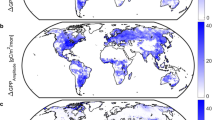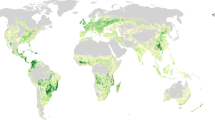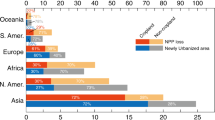Abstract
The human population and its consumption profoundly affect the Earth's ecosystems1,2. A particularly compelling measure of humanity's cumulative impact is the fraction of the planet's net primary production that we appropriate for our own use3,4. Net primary production—the net amount of solar energy converted to plant organic matter through photosynthesis—can be measured in units of elemental carbon and represents the primary food energy source for the world's ecosystems. Human appropriation of net primary production, apart from leaving less for other species to use, alters the composition of the atmosphere5, levels of biodiversity6, energy flows within food webs7 and the provision of important ecosystem services8. Here we present a global map showing the amount of net primary production required by humans and compare it to the total amount generated on the landscape. We then derive a spatial balance sheet of net primary production ‘supply’ and ‘demand’ for the world. We show that human appropriation of net primary production varies spatially from almost zero to many times the local primary production. These analyses reveal the uneven footprint of human consumption and related environmental impacts, indicate the degree to which human populations depend on net primary production ‘imports’ and suggest policy options for slowing future growth of human appropriation of net primary production.
This is a preview of subscription content, access via your institution
Access options
Subscribe to this journal
Receive 51 print issues and online access
$199.00 per year
only $3.90 per issue
Buy this article
- Purchase on Springer Link
- Instant access to full article PDF
Prices may be subject to local taxes which are calculated during checkout

Similar content being viewed by others
References
Vitousek, P. M., Mooney, H. A., Lubchenco, J. & Melillo, J. M. Human domination of Earth's ecosystems. Science 277, 494–499 (1997)
Wackernagel, M. et al. Tracking the ecological overshoot of the human economy. Proc. Natl Acad. Sci. USA 99, 9266–9271 (2002)
Vitousek, P. M., Ehrlich, P., Ehrlich, A. & Matson, P. M. Human appropriation of the products of photosynthesis. Bioscience 36, 368–373 (1986)
Rojstaczer, S., Sterling, S. M. & Moore, N. J. Human appropriation of photosynthesis products. Science 294, 2549–2552 (2001)
Schimel, D. et al. Contribution of increasing CO2 and climate to carbon storage by ecosystems in the United States. Science 287, 2004–2006 (2000)
Haberl, H. Human appropriation of net primary production as an environmental indicator: Implications for sustainable development. Ambio 26, 143–146 (1997)
Field, C. B. Global change: Enhanced: Sharing the garden. Science 294, 2490–2491 (2001)
Daily, G. C. et al. Ecosystem services: benefits supplied to human societies by natural ecosystems. Issues Ecol. 2, 1–16 (1997)
O'Neill, R. V. & Kahn, J. R. Homo economus as a keystone species. Bioscience 50, 333–337 (2000)
Haberl, H., Krausmann, F., Erb, K. H. & Schulz, N. B. Human appropriation of net primary production. Science 296, 1968–1969 (2002)
Food and Agriculture Organization of the United Nations, FAOSTAT 2001 Database (UNFAO, Rome, 2001)
Center for International Earth Science Information Network, Gridded Population of the World (GPW) version 2 (Columbia Univ.; International Food Policy Research Institute (IFPRI); and World Resources Institute, New York, 2000)
Potter, C. S. et al. Terrestrial ecosystem production: a process model based on global satellite and surface data. Glob. Biogeochem. Cycles 7, 811–841 (1993)
Slayback, D. A., Pinzon, J. E., Los, S. O. & Tucker, C. J. Northern hemisphere photosynthetic trends: 1982–99. Glob. Change Biol. 9, 1–15 (2003)
Cramer, W. et al. Comparing global models of terrestrial primary productivity (NPP): overview and key results. Glob. Change Biol. 5(Suppl. 1), 1–15 (1999)
Luck, M. A., Jenerette, G. D., Wu, J. G. & Grimm, N. B. The urban funnel model and spatially heterogeneous ecological footprint. Ecosystems 4, 782–796 (2001)
van den Bergh, J. & Verbruggen, H. Spatial sustainability, trade, and indicators: an evaluation of the ‘ecological footprint’. Ecol. Econ. 29, 61–72 (1999)
Holdren, J. P. & Ehrlich, P. R. Human population and global environment. Am. Sci. 62, 282–292 (1974)
United Nations Population Division World Population Prospects: The 2000 Revision and The World Population in 2003 (United Nations Population Division Department of Economic and Social Affairs, New York, 2003)
World Resources Institute Disappearing Food: How Big are Postharvest Losses? (World Resources Institute Sustainable Development Information Service, Washington DC, 1998); available at 〈http://www.wri.org/trends/foodloss.html〉
De Padua, D. B. in Accelerating Agricultural Development (eds Drilon, J. D. & Sanguiguit, G. F.) 135–154 (SERCA College, Laguna, 1978)
Smil, V. Biomass Energies: Resources, Links, Constraints (Plenum, New York, 1983)
Ince, P. J. Industrial Wood Productivity in the United States 1900–1998 (Research Note FPL-RN-0272, USDA Forest Service, Madison, 2000)
Pulkki, R. E. Literature Synthesis on Logging Impacts in Moist Tropical Forests (working paper GFSS/WP/06, Forest Products Division, UNFAO, Rome, 1997)
Skog, K. E., Ince, P. J. & Haynes, R. W. Wood fiber supply and demand in the United States. Proc. N. Am. For. Comm. [online] 〈http://www.fpl.fs.fed.us/documnts/pdf2000/skog00a.pdf〉, 1998
Sere, C. & Steinfeld, H. World Livestock Production Systems (Animal Production and Health Paper 127, FAO, Rome, 1996); available at 〈http://www.fao.org/WAICENT/FAOINFO/AGRICULT/AGA/LSPA/Paper127/cover1.htm〉
Council for Agricultural Science and Technology, Animal Agriculture and Global Food Supply (Task Force Report R135, Ames, 1999); available at 〈http://www.cast-science.org/cast/pub/anag_nr.htm〉
Oltjen, J. W., George, M. R. & Drake, D. J. in Computers in Agricultural Extension Program (eds Watson, D. G., Zazuelta, F. S. & Bottcher, A. B.) 58–63 (American Society of Agricultural Engineers, St Joseph, 1992)
Lieth, H. in Primary Productivity of the Biosphere (eds Lieth, H. & Whittaker, R. H.) 119–130 (Springer, New York, 1975)
Acknowledgements
We thank K. Carney, N. Christiansen, G. Daily, R. Defries, J. Hellmann, J. Hicke, G. Orians, N. Sanders, P. Vitousek, P. Matson and P. Ehrlich for comments, C. Tucker for providing satellite data, and G. Asrar, J. Kaye, G. Gutman and D. Wickland of the US National Aeronautics and Space Administration for financial support.
Author information
Authors and Affiliations
Corresponding author
Ethics declarations
Competing interests
The authors declare that they have no competing financial interests.
Rights and permissions
About this article
Cite this article
Imhoff, M., Bounoua, L., Ricketts, T. et al. Global patterns in human consumption of net primary production. Nature 429, 870–873 (2004). https://doi.org/10.1038/nature02619
Received:
Accepted:
Issue Date:
DOI: https://doi.org/10.1038/nature02619
This article is cited by
-
Gridded Datasets for Japan: Total, Male, and Female Populations from 2001–2020
Scientific Data (2023)
-
Subsistence of early anatomically modern humans in Europe as evidenced in the Protoaurignacian occupations of Fumane Cave, Italy
Scientific Reports (2023)
-
Predictive modelling of heating and cooling degree hour indexes for residential buildings based on outdoor air temperature variability
Scientific Reports (2023)
-
Pattern changes of ecological product trade in countries along the Belt and Road
Environmental Science and Pollution Research (2023)
-
Ecosystem degradation and the spread of Covid-19
Environmental Monitoring and Assessment (2023)
Comments
By submitting a comment you agree to abide by our Terms and Community Guidelines. If you find something abusive or that does not comply with our terms or guidelines please flag it as inappropriate.



